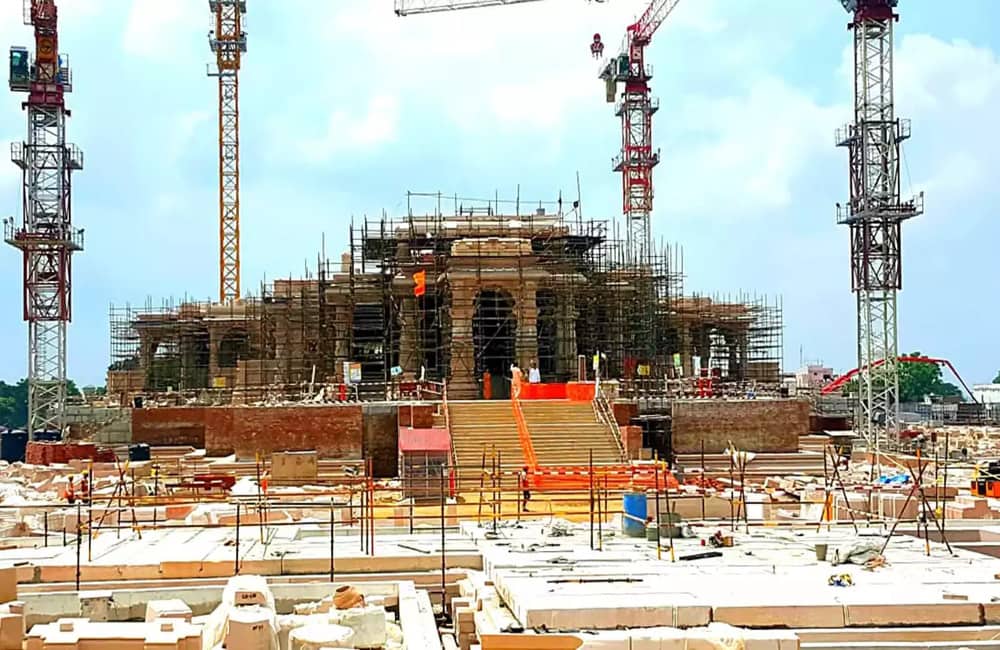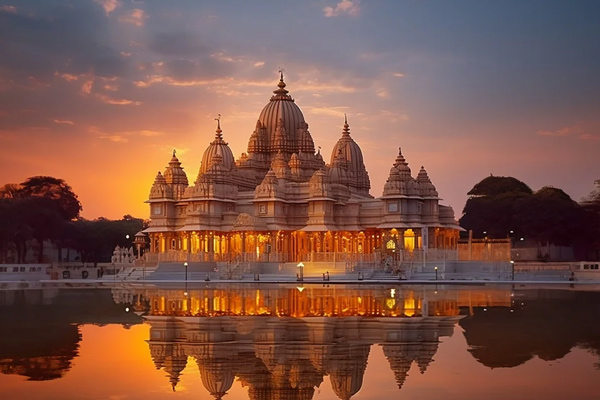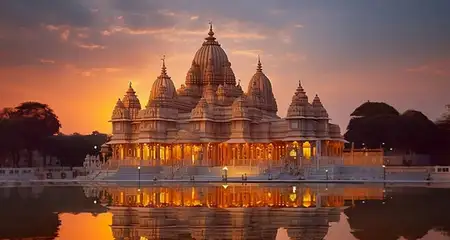The Ayodhya Ram Mandir is a Hindu temple dedicated to Lord Ram. It is located in Ayodhya, Uttar Pradesh, India. The Lord Shri Ram temple has been the centre of a political and religious dispute in India which dates back to 1858. After the dispute was resolved in November 2019, a new temple at the birthplace of lord Shri Ram or Ram Janm Bhumi is being built.
The Ram Mandir Ayodhya is set to organise the ‘Pran Pratishtha’ ceremony on January 22, 2024, which will be performed by the Prime Minister of India, Shri Narendra Modi.
Check the Ayodhya Ram Mandir opening date, history, architecture, donations, facilities, and how to reach it.
Ayodhya Ram Mandir History
Ayodhya Ram Janmabhoomi history is centuries old and is built on the site that is believed to be the Janmabhoomi or the birthplace of Lord Ram, an incarnation of Vishnu and one of the most admired Hindu deities. In the 16th century, the Mughal emperor Babar demolished the temple and built a mosque in its place. The mosque, known as the Babri Masjid, stood on the Ram Mandir site for centuries. In 1992, it was demolished by Hindu nationalists triggering communal tensions and widespread violence in the country.
The Mandir-Masjid dispute revolved around the ownership of the site and hence the Ayodhya location dispute has been controversial in Indian politics for decades.
In the year 2019, the dispute was finally settled by the Supreme Court of India, which ruled in favour of the construction of a Ram Mandir on the site. A trust was formed by the Indian government, Shri Ram Janmabhoomi Teerth Kshetra to oversee the construction of the temple.
Ayodhya Ram Mandir Inauguration Date
The Ram Mandir Ayodhya opening date 2024 is 22 January 2024, Monday by Narendra Modi, the Prime Minister of India. The inauguration of Ram Mandir will also be attended by spiritual leaders including, Dalai Lama, Mata Amritanandamayi, Yoga guru Baba Ramdev and Jaggi Vasudev. The temple trust has also invited business tycoons, including Mukesh Ambani, Gautam Adani, and Ratan Tata.
Ayodhya Ram Mandir Construction

In March 2020, the Shri Ram Janmabhoomi Teerth Kshetra Trust began the first phase of construction of the Ram Mandir Ayodhya location. The construction was put to a halt as it was temporarily suspended due to the COVID-19 pandemic lockdown, imposed by the Indian government. After a few months, the construction officially started again in August 2020 with the Bhoomi Poojan Ceremony.
Two Shaligram rocks which are reportedly 60 million-year-old were sent from the Gandaki river in Nepal to carve the idol for Ram Janki mandir in February of 2023. These stones weigh 26 tonnes and 14 tonnes respectively.
Ayodhya Ram Mandir Temple Architecture
The Ayodhya Ram Mandir is built in the grand Nagara style of temple architecture, characterised by the towering shikhara or spires. The temple is spread across an area of 2.77 acres and is built using pink sandstone. It is surrounded by several smaller shrines in a large courtyard dedicated to other Hindu deities. The temple has a giant Shaligram stone, a naturally black-coloured stone believed to represent Lord Vishnu which was brought from the Gandaki River in Nepal.
The temple has three floors and is 161 feet high. The first floor of the temple is dedicated to Lord Ram, the second floor of the temple is dedicated to Lord Hanuman, and the third floor is a museum showcasing the history and culture of Ayodhya.
The temple complex also includes a Yagyashala, a hall for conducting Yagyas or Hindu fire rituals, a medical facility, and a community kitchen. The temple complex is expected to become a major cultural and religious centre and is spread over 67 acres (10 acres for the temple and 57 acres for the complex), attracting millions of devotees from around the world. Ram Mandir area in km is 0.040 sq. km and the complex area is 0.23 sq. km.
Suggested Read: Who Can Visit Ram Mandir Ayodhya & How
Ram Mandir Ayodhya Specialities
The temple is equipped with modern facilities like solar panels, ramps for elder devotees, medical aid, bank/ATM, public utilities, and food shelter for devotees. The Mata Sita Rasoi Annakshetra is a food shelter that offers mass-feeding facilities for devotees visiting the temple. It features a kitchen, large food storage, systematic cutlery and utensil storage, and hand-washing facilities.
- 2100 kg Bell: A bell weighing 2,100 kg made of ‘Ashtadhatu’ (an alloy of eight metals) has been prepared for Ram Mandir in Jalesar, Uttar Pradesh. The bell took two years to get prepared by the local artisans.
- Gifts from Different Places: More than 3,000 gifts for Lord Ram Mandir from Janakpur in Nepal have arrived in Ayodhya. Janakpur is believed to be Goddess Sita’s birthplace. The gifts include silver shoes, ornaments and clothes. The gifts were transported in a convoy of around 30 vehicles from the Janakpur Dham Ramjanaki Temple in Nepal to Ayodhya.
- Time Capsule: A time capsule 2000 feet below the Ram Mandir has been placed. The capsule contains all the facts about the Janmabhoomi so that no controversy related to the site will arise again.
- Shree Ram Bricks: Special bricks named after Lord Ram are being used to construct the Shri Ram Janmabhoomi Temple in Ayodhya. These bricks are made using a unique process to make them stronger and more durable than regular bricks. They are also inscribed with the words “Shri Ram 2023” to commemorate the year of the temple’s construction.
Ayodhya Ram Mandir Donations
Some reports indicated that the Ram Mandir budget at the Ayodhya location can reach up to Rs.3600 crore. The temple trust launched a “mass contact and contribution campaign” to reach 500-600 million people across the nation. As of October 2023, Rs.3500 crore has been collected from domestic voluntary donations across India.
How to Reach Ayodhya Ram Mandir
Ram Mandir Ayodhya is well connected by all the modes of transportation i.e. road, train, and airways. You can reach the Ayodhya location:
- By Air:
- Maharishi Valmiki International Airport Ayodhya Dham (17 km)
- Gorakhpur Airport (139 km)
- Chaudhary Charan Singh International Airport, Lucknow (156 km)
- By Train: The trains are well-connected to Ram Mandir railway station in Ayodhya from all the major cities in India.
- Ayodhya Junction (2.5 km)
- Gorakhpur Junction (113 km)
- Lucknow Junction (144 km)
- By Road: There are public buses by Uttar Pradesh Transport Corporation and private buses, and taxis are available for Ram Mandir station. Regular buses are available from Lucknow, Delhi, Varanasi, and Gorakhpur to reach the Ayodhya location.
There are many accommodations for devotees and tourists visiting Ayodhya like Dharamshalas and hotels in Ayodhya.
Places to Visit Near Shri Ayodhya Ram Mandir
Some famous places to visit near Ayodhya Shri Ram Mandir are:
- Hanuman Garhi Mandir
- Kanak Bhavan Temple
- Nageshwarnath Temple
- Raja Mandir
- Sri Maniram das Chavani
- Sita Ki Rasoi
FAQs
Q. How many years will it take to complete Ram Mandir?
A. Phase 1 of the construction will be completed by January 2024. The rest of the phases will be completed by the end of 2024.
Q. How many years old is the Ram Mandir case?
A. The first case for the dispute was filed in the year 1885.
Q. Who is funding Ram Mandir?
A. The Ram Mandir is funded by donations.
Q. Which state chief minister laid the foundation stone of Ram Mandir?
A. The chief minister of Uttar Pradesh, Shri Yogi Adityanath laid the foundation stone of the Ram Mandir.
Q. Why is Ram Mandir built in Ayodhya?
A. Ayodhya is believed to be the birthplace of Lord Ram and hence the Ram Mandir is being built in Ayodhya.
Q. What is the height of Ram temple in Ayodhya?
A. The height of Shri Ram Mandir Ayodhya will be 161 feet.
Q. What is the real name of Ayodhya?
A. Historically Ayodhya was known as Saketa.
Q. Who is the owner of the Ram temple?
A. Shri Ram Janmabhoomi Teerth Kshetra manages all the operations of Shri Ram Mandir.
Q. Which is the largest Ram temple in the world?
A. Viraat Ramayan Mandir in Bihar will be the largest temple dedicated to Lord Ram.
Q. What is the timing of Ram Janmabhoomi Darshan?
A. The temple is open from 7 AM to 11 AM and from 2 PM to 7 PM on regular days.
Q. What is the old name of Ayodhya City?
A. Historically Ayodhya was known as Saketa.
Q. Who is the king of Ayodhya?
A. During Ramayana, Dashratha was the king of Ayodhya. Lord Ram, the eldest son of Dashratha became the king after him.
Q. Which river flows in Ayodhya?
A. Saryu River flows through Ayodhya and is believed that it washes away impurities.
Q. Where was Sita born?
A. Goddess Sita was born in Janakpur, Nepal.
Q. When did the Ram Janmabhoomi movement start?
A. The first case for the dispute was filed in the year 1885.
Q. Who ruled Ayodhya after Ram died?
A. After the death of Ram, his son Kush ascended the throne.
Q. How old is Ramayana?
A. According to historians, the earliest stage of Ramayana texts is the 3rd century.
Q. Who is the writer of Ramayana?
A. Maharishi Valmiki is the writer of Ramayana.
Q. For how many days did Sita ji stay in Lanka?
A. It is believed that Goddess Sita lived in Sri Lanka for roughly one year.




























